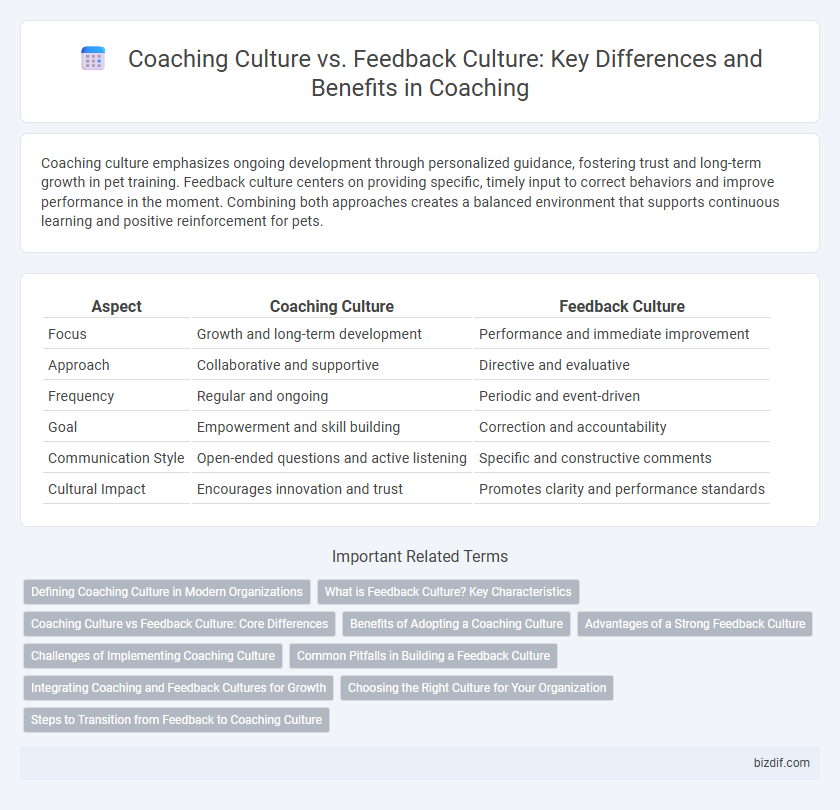Coaching culture emphasizes ongoing development through personalized guidance, fostering trust and long-term growth in pet training. Feedback culture centers on providing specific, timely input to correct behaviors and improve performance in the moment. Combining both approaches creates a balanced environment that supports continuous learning and positive reinforcement for pets.
Table of Comparison
| Aspect | Coaching Culture | Feedback Culture |
|---|---|---|
| Focus | Growth and long-term development | Performance and immediate improvement |
| Approach | Collaborative and supportive | Directive and evaluative |
| Frequency | Regular and ongoing | Periodic and event-driven |
| Goal | Empowerment and skill building | Correction and accountability |
| Communication Style | Open-ended questions and active listening | Specific and constructive comments |
| Cultural Impact | Encourages innovation and trust | Promotes clarity and performance standards |
Defining Coaching Culture in Modern Organizations
A coaching culture in modern organizations integrates continuous learning and development into daily workflows by encouraging open dialogues that promote growth, self-awareness, and accountability. Unlike a feedback culture that primarily focuses on performance evaluation, coaching culture emphasizes collaborative problem-solving, emotional intelligence, and personalized support to unlock employee potential. This approach drives higher engagement, innovation, and resilience by embedding coaching principles into leadership practices and organizational values.
What is Feedback Culture? Key Characteristics
Feedback culture is an organizational environment where continuous, constructive communication is embedded into everyday interactions, promoting growth and learning. Key characteristics include openness to receiving and giving feedback, regular feedback loops, and a non-judgmental approach that fosters trust and psychological safety. This culture drives performance improvement by encouraging transparency, accountability, and mutual respect among team members.
Coaching Culture vs Feedback Culture: Core Differences
Coaching culture emphasizes ongoing development through personalized guidance and active listening, fostering long-term growth and self-awareness. Feedback culture centers on providing specific, often performance-related input aimed at immediate improvement and accountability. While coaching culture cultivates trust and collaboration, feedback culture prioritizes clarity and corrective measures.
Benefits of Adopting a Coaching Culture
Adopting a coaching culture enhances employee engagement by fostering continuous learning and development, which leads to increased performance and job satisfaction. It promotes open communication and trust, enabling individuals to take ownership of their growth and align personal goals with organizational objectives. This cultural shift also supports resilience and adaptability, empowering teams to navigate change more effectively than a traditional feedback culture.
Advantages of a Strong Feedback Culture
A strong feedback culture accelerates employee development by fostering continuous learning and open communication, leading to improved performance and higher engagement. It enhances transparency and trust within teams, enabling faster identification of challenges and collaborative problem-solving. Organizations with a well-established feedback culture experience increased adaptability and innovation, driving sustained business growth.
Challenges of Implementing Coaching Culture
Implementing a coaching culture faces challenges such as resistance to change, lack of leadership commitment, and insufficient training resources. Organizations often struggle with embedding coaching mindsets versus merely promoting feedback practices, which requires sustained behavioral shifts. Measuring the impact of coaching initiatives and aligning them with business goals remains a critical challenge for long-term success.
Common Pitfalls in Building a Feedback Culture
Common pitfalls in building a feedback culture include a lack of psychological safety, leading employees to withhold honest input due to fear of repercussions. Overemphasis on criticism rather than constructive dialogue can erode trust and reduce engagement, hindering open communication. Failure to train leaders and employees in effective feedback techniques results in miscommunication and resistance, undermining the culture's intended benefits.
Integrating Coaching and Feedback Cultures for Growth
Integrating coaching and feedback cultures creates a dynamic environment where continuous learning and growth thrive, fostering employee engagement and performance improvement. Coaching culture emphasizes personalized development through open-ended questions and active listening, while feedback culture promotes timely, specific, and constructive input, together enabling holistic professional growth. Organizations that blend these approaches see enhanced communication, trust, and accountability, driving sustained success and innovation.
Choosing the Right Culture for Your Organization
Coaching culture emphasizes continuous development through personalized guidance, fostering long-term growth and employee empowerment, whereas feedback culture centers on regular performance evaluations to improve specific skills and processes. Organizations prioritizing innovation and resilience benefit from a coaching culture, which encourages open dialogue and proactive problem-solving. Selecting the right culture involves aligning with business goals, employee needs, and leadership style to create a sustainable environment for success.
Steps to Transition from Feedback to Coaching Culture
Implementing a successful transition from a feedback culture to a coaching culture involves embedding continuous learning and development into daily interactions, promoting open dialogue that encourages growth rather than judgment. Key steps include training leaders to adopt a coaching mindset, establishing regular one-on-one coaching sessions, and integrating reflective practices that focus on skill-building and long-term performance improvement. Organizations should also leverage data-driven insights to personalize coaching approaches, fostering psychological safety and employee engagement throughout the transformation process.
Coaching culture vs feedback culture Infographic

 bizdif.com
bizdif.com